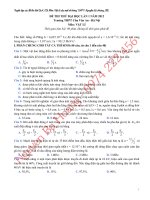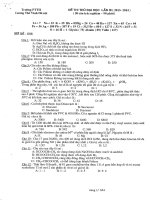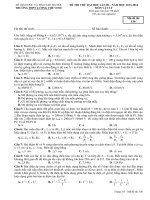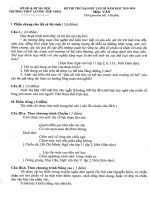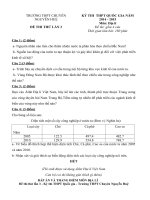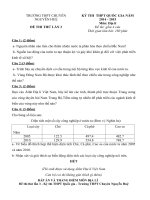ĐỀ THI TIẾNG ANH CAO HỌC ĐẠI HỌC SƯ PHẠM CÓ KEY
Bạn đang xem bản rút gọn của tài liệu. Xem và tải ngay bản đầy đủ của tài liệu tại đây (155.71 KB, 12 trang )
1
!"!#$%
!"#$%
&'(&)*&&+&', ./01231
45%(-./01231
&'()*'+, /%0123450 20000 0.6000 7%01282%900:2%5
925"255050";<6<*"&.*220020925"25500 2000
00 0. 0< 2 82%5 90500< =" 0 %05 25 7%012 " = 0 0
25502"200>052:090582%?0 20.
A. have to B. can C. must D. mustn’t
A. they don’t, neither B. neither have they
C. neither do they D. they aren’t, either.
!!!"
A. me B. them C. it D. they
#$!!$%&"
A. to hear B. when hear C. hearing D. hear
'()*+!
A. who B. where C. what D. why
,% -.!
1
1
2
A. the most B. more C. so D. as
/0*%*+%%%
A. working B. work C. has worked D. are working
1$2 3!
A. fastly B. great C. quickly D. slow
40 "!
A. deciding B. is deciding C. decides D. decided
3$2
A. his B. them C. their D. they
!*5"!'33
A. do B. did C. could D. will
6!..%!".7
A. who B. which C. whom D. whose
$%*.*!
A. In order B. Because C. Despite D. Although
#$"! !.!5
A. so B. and C. but also D. or
'$% 2%""!"
A. persuades B. persuade C. to persuade D. persuading
, ",
0 8! 90%!
5!645718 3391 6$%!
/$: !*;0;
0 039:01 9 6
1<=;%"!*
0 % 9% !1185046!$ 6%
40 >!>
0 939:03/$ ! 6
3?."%%!
2
2
3
0 9 6; 310
$ % %!2+
!
0 9 6350 6
;%%@%!
0 9 418 4$0: 6
1
!%!%
0 050;050 9 6!
#?%%22%
0 3;! 9 6
'8*2%!"
0 ;411<0 9 6
45=(./01231
&'()*'+,-'7%012@A440 00 0:2%5%"050"925"255050";<6<
*<"&.'"01:8020%"050"925"2550%0 0"25"05:250
00 020 2550 .0<282%590500<="0%052:07%012"=0
0 25502"200>052:090582%?0 20.
,$**2-!%
0 9 >
/$! !+%
% 9 6
19!%!2%!!!
0 9 6
4$&"*!!
0 = 6
3$.2!5A
3
3
4
0 9 6
* &"*!
0 9 6
*!+%%*!.
0 = 6
8!*%!.
0 9 >
#?"& !!.%*
% 9 6
'B5%
0 9 >
,$33%%!0!*%2
0 = 6
/)2!"%%!"2
0 = 6
1*-2C""%
0 9 >
40%*%%!5@!!
0 = 6
#3*%
0 9 >
# %%%
0 9 6
#0.@2
0 = 6
#.!
0 9 6
4
4
5
##?%."*."*
0 = 6
#'$!. %%
0 9 >
#,CA@%*"!"
0 9 >
#/$%"!
% 9 6
#19"*.*
0 9 >
'3$*!%%
0 = 6
'D2%%."
% 9 6
'$*!"*!*
0 9 6
'? !*%
0 9 >
'#$%"%"!%.%
0 = 6
''2&! %*.
0 9 >
&'"&%>'&&'?-./01231
5
5
6
&'()*'+,-'7%0124@AB0 00 0:2%505501250";<6<*<"&.
'"01:80 2550 055012.0<282%590500<="0%052:07%012"
=0 0 25502"200>052:090582%?0 20.
@&''
@3589/A606A051397
',5%7
0 ("!
9 E !"!
$*5%
6 0606A0513B 089/A
!8C0648 !0
''@'>&
47354!
'/$2%
0 2.%
9 !
2.%
6 028C0648 !0!13;35C!$3:47
$FE$;
D'@'>%
'1$2%
0 2.!
9 !2.@
"!2.*
6 28C014508 04<053:47
E&'F>%
@5360G@5!:47H 09!A5457;!99A0
89310::/5!$;00C0:1
'4$"!
0 *!
9
@+G!
6 8 4$0!13<0!$ 3/51
>%&'@%FF'I
'%
,3!7
0 0%%
9 9!
'463/4!3/1534:
6 !
6
6
7
45=
&'()*'+, '0 12<82%950"C0.) 0:2290"852D08E
7%012.F257%012@AB< 2200200905<;<6<*25&.0<282%5905
00<="0%052:07%012"=0 0 25502"200>052:0
90582%?0 20.;9052:07%012:2290202:9
0"250"00.
4114$0
$!%!2.5%%*0054!60!$
%!.*5%G+%25%%*
07 "%"&
25% !*!5% ; !8
"%!-%.%6%!5%
*" %2G%
.*;D%**$H&!
"!* %!%*2
Câu 61: A mistake made by many people is that all films are for _________.
A. entertainment only B. students and schools
C. education only D. various purposes
Câu 62: Education films are made _________.
A. teacher only B. for teaching and learning
C. for workers D. for entertainment
Câu 63: Which one below is not true about training films? They are used _________.
A. to show workers how to work on a machine B. to introduce machinery
C. in industry D. to advertise industry
Câu 64: When we watch films, we can do all following things EXCEPT _________.
A. get more knowledge B. make films ourselves
C. meet interesting people D. enjoy the beauty of nature
Câu 65: Which one below is not mentioned as the purpose of films?
A. They are made for instructions. B. They are made for entertainment.
C. They are made for wars. D. They are made for education.
Câu 66: The word entertainment in line 1 is about something that we _________.
A. study B. follow C. remember D. enjoy
Câu 67: The word They in line 2 refers to _________.
A. Subjects B. Kind of films C. People D. Educational films
Câu 68: The relative pronouns which in line 4 refers to _________.
A. training films B. foreign language C. industry D. educational films
4114$0
$%%!#>!>."!%%*"!05
4$4!1 "* "9I)!%"!
%%%!*2%.%%.%*%"J
"%%
7
7
8
G%!%*%
%%( 07 2 .0%
"!% *!;%2%%!"*
!
K%.%*%" "
Câu 69: What is the writer trying to do in this text?
A. To thank her son for his beautiful music B. To describe her son’s hobby
C. To give advice for young people D. To complain about her son
Câu 70: To persuade his parents to buy him a drum, the boy said that _________.
A. the drum would keep him out of
trouble.
B. the drum is cheap.
C. he would invite his friends home. D. he is tired of playing computer games.
Câu 71: What does the writer think about the boys?
A. They are good boys. B. She does not care for them.
C. They play their instrument well. D. They never look at her.
Câu 72: Where do the boys sometimes play?
A. In a local club B. At a party C. In a night club D. At school
Câu 73: How do parents feel about their decision to buy their son a drum?
A. Regret B. Worried C. Happy D. Tired
Câu 74: The word against in line 2 is the same as _________.
A. happy with B. surprised at C. agree with D. not agree
with
Câu 75: The word they in line 6 refers to _________.
A. Both their son and his friends B. Their family
C. Their son and his drum D. Their son’s friends only
4114$0
G"%" !1,$%%
!*"%!*%.."
*%$.; 3."*!
5"$!%*
""
E !*!*"%%*$
%22439L%*%!*"!%
*%!*)*)!*%!!9L
(.).*"%
Câu 76: What is the main topic of the passage?
A. The World Cup B. Football C. Sport D. Pele
Câu 77: In the football game, we often see _________ players on the field.
A. twenty-two B. two C. four D. eleven
Câu 78: What parts of the body can the players use to control the ball?
A. His hands only
B. His head and hands
C. His head only
D. His feet and head
Câu 79: Who on the field can touch the ball with his/ her hands?
8
8
9
A. The goal keeper
B. Only one team
C. Nobody
D. Any player
Câu 80: The first World Cup competition was _________.
A. in 1863 B. in 1930 C. many centuries ago D. in Brazil
Câu 81: What information below is NOT CORRECT about Pele?
A. He is from Brazil. C. He is a famous football player.
B. He is a famous goal keeper. D. He once played for New York.
Câu 82: What does who in line 3 refer to?
A. the other team B. the goal keeper C. the players D. each team
4114$0J
I$ " "+J !8)
I2%"J
8 < * . *
4/*5 >!>*
8E 07% !
.E)%2%
8M<947A7045$!%2! "!*
!8!% "
&!!%;; 3! ! !
2!
1"7
A. As soon as they are born. C. At the age of three and six.
B. When they hear music. D. When they learn the violin.
1#857
A. Her own friends C. her children’s friends
B. Three or four-year-old children D. her children
1'"'"8%7
A. Sometimes there are parents in the class. C. Each lesson is one hour long.
B. Each course lasts only two weeks. D. Ten to twelve students learn together.
1,! !7
A. They may move to traditional classes. C. They stop going to music classes.
B. They can enjoy music. D. They become great violinists.
1/$ 07'*
A. groups B. twelve C. Margaret D. Margaret’s students.
11$; 3*
A. great violinistsB. students C. music D. small children
14$+<947A7045%
9
9
10
A. listen to music only C. listen to music and play
B. play with no rules D. read music and play
43$"
A. how to find a good music teacher C. why Margaret likes the violin
B. how Margaret likes the violins D. Margaret’s students
&'(*?./01231
&'()*'+, '0 1282%950"052%2:00 0.*22002000 0GH'*H
25502"200>052:090582%?0 20.
4
09"$%%2
99"$%%2
9"$%%2
6=3A4:!6:!:K4L0: 06002$H4:0! 05:!:(
4
0$%%!%".
9 06483/0: !163074:</!A48C!3 !1;4990(
$%%!*".
6$%%!%".
4
0%605!84<03<9049;471;43A01/88011B/9! 0!5M3A1(
90%!"*&"
0%!"*!&"
60%!"*&"
4#
0?"%5.2%
90;41940A/ 0644$0:3N!1 !1;35C!260(
10
10
11
?"%5.2%
6?"%5.2%
4'
0$";L
9 0A018 0010!1<53:/80:!;!O0594:(
$";L
6$";L
4,
04557!$ 14506350A04/2B/9 41459011!$ 1(
9;!%"2*
;!%"2*
6;!"2*
4/
0 01356;4113 04P7 4!:015370:6313B 0853<1(
9$% !!%*
$% !!%*
6$% !!%*
41
0$%C"
9$%C"
08/1363Q80539: 0<4110$05133<0 0!5A4$1(
6$%C"
44
11
11
12
0%54!84845576350<4110$051 44<940(
90!%
0!%
60!%
33
0 010 0494568938CA084/101 0:!:K;43A0940B3518 339(
9;%."*
;%."*"*
6;%.2"*
>>>R>>>
12
12
